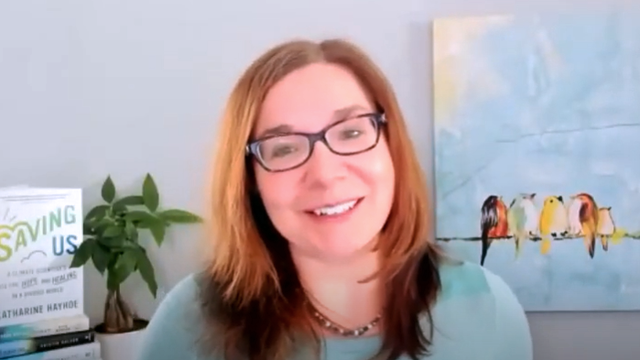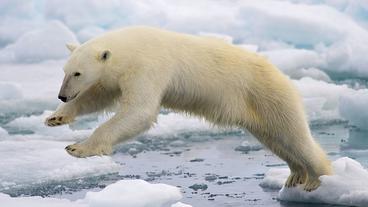Noted environmental scientist Katharine Hayhoe says the best way to address the climate crisis is pretty simple: we all should talk about it with people we know.
That talk will lead to action, on an individual and then a community level, which will in turn influence governments, businesses, and other organizations to make the large-scale systemic changes necessary to mitigate the potential damage from climate change.
Hayhoe delivered her message at a virtual event Tuesday as part of the Humphrey School of Public Affairs’ Swain Climate Policy Series, which honors retired government, business, community, and University of Minnesota leader Tom Swain.
Hayhoe is chief scientist for The Nature Conservancy, a scholar at Texas Tech University, and author of a new book, Saving Us: A Climate Scientist’s Case for Hope and Healing in a Divided World.
Her presentation was co-sponsored by the Big Ten Conference's Democracy in the 21st Century collaboration, and students from all 14 schools in the conference were invited to participate.
Here are excerpts from Hayhoe’s presentation. Her remarks have been edited for length and clarity.
Defining climate change:
Today the climate is changing faster than any time in the history of humans on this planet. Over tens of thousands of years, the earth’s average temperature has gone up and down. But over the last century, it has gone up so steeply that it is now warmer than any time during human civilization on this planet.
That’s important because our infrastructure, our food, our water systems, our cities, our supply chains, our economy – everything is built on the assumption that the climate is stable. It's been warmer before and it's been colder before, but thousands of years ago we didn't have eight billion humans living on the earth and using its resources.
Climate change is not about the future of the planet itself. The planet will be orbiting the sun long after we're gone. It's about us humans and a lot of other things that share the earth with us. We are the ones most at risk.
When did all of this begin? It was in the 18th century and the Industrial Revolution, when people figured out how to dig up massive amounts of coal, and then oil and gas, from under the ground and burn it. That produces heat-trapping gases. Our planet already has a natural blanket of heat-trapping gases that keep us alive. But by burning fossil fuels, the emissions are like an extra blanket we're wrapping around our planet. and as a result the temperatures on the earth keep rising.
And that affects our weather, causing more dramatic and destructive weather patterns. For example, we just had three 500-year flood events in three years in the city of Houston. We saw a 100-plus degree heat wave in the Pacific Northwest last year.
Back in the 1980s, when they first started tracking this data, there was a $1 billion weather or climate event somewhere in the United States on average every four months. But just in the last decade, we’ve seen a $1 billion weather and climate disaster on average every three weeks (adjusted for inflation). That's a huge change.
Climate change is not a stand-alone issue. It affects everything else that we care about. It affects our infrastructure, our economy, our energy, our water, our natural resources, our health. It affects our food, our biodiversity, our conservation, our justice and equity issues.
Why people aren’t paying more attention to climate change:
Since climate change affects every aspect of our lives, we have to ask why we aren’t treating it like an emergency. It’s because of human nature and the way our brains are wired. Humans are very prone to something called psychological distance. We are very good at seeing risks as being far away from us in time and space, as abstractions instead of concrete issues.
There are surveys that show most people in the U.S. believe in climate change and that it can be harmful. But – most people don't think it will harm them personally.
The messages that scientists and the media send out too often focus on more global impacts – like the threat to polar bears, for example. I care about polar bears, but if we make this only about the polar bears, we totally miss the boat. After the polar bears, we humans are next.
So we need to talk about climate change differently. You don’t talk about polar bears in Iowa. You talk about corn. You talk about flooding. You talk about wind energy. In Texas, you talk about cotton farming. Out west, you talk about wildfires, and so on.
How to solve the climate crisis:
I like to refer to John Holdren, a physicist at Harvard who served as President Obama’s science advisor. When he talks about how to address climate change, he says we have three choices: mitigation, adaptation, and suffering.
We can mitigate the situation by reducing our emissions. We can adapt by preparing for a different future. Or we can suffer. That's not a word you hear scientists saying often. Holdren explains that we're going to do some of each; the question is what the mix is going to be.
The more we cut our emissions, the less adaptation is required, and the less suffering there will be. These are the choices that face all of us. Not just climate scientists, not just decision makers, but every single person on this planet.
The big solutions to climate change look like this:
- Stop putting so much carbon into the atmosphere (mitigation)
- Take as much carbon out of the atmosphere as we can (mitigation)
- Build resilience to the impacts that are already here, that we can no longer avoid (adaptation)
How individuals can make a difference:
The absolute best way to make the necessary changes to address climate change is by all of us talking about it with people we know. Most people don’t talk about climate change with others. So if you don't talk about it, why would you care? If you don't care, why would you do anything to fix it?
Surveys show that the vast majority of us are worried about climate change, but half of us feel the situation is hopeless and don’t know where to start or how to help. So the goal of talking about climate change is to talk to all those people who are worried, help them understand how we can become active, and what we can do to fix this problem.
Sharing scary facts about climate change won’t motivate people to take action. If we don't know what to do, scary facts don't activate us, they just paralyze us.
What works is talking about how climate change affects us here and now, in ways that are relevant to our lives today. And then we start to look for solutions, like reducing food waste and eating more plants, biking or walking instead of driving when we can, urging cities and schools and universities to transition to cleaner energy, and so on. Then people will feel empowered and keep pushing for more change.
Our brains are wired this way, to associate forward action with a reward, not avoiding harm. When we produce hope, not dread, it encourages people to act.
The goal of the conversation is not to tell people about climate change, it’s to expand the number of people in the conversation. So my challenge to you is to talk about climate change with the people around you. Talk with them about why it matters and work together to find solutions that you can do on your own or with your community.
About the Swain Climate Policy Series
Answering Tom Swain’s call to action, Advancing Climate Solutions. Now. The Swain Climate Policy Series seeks to engage and energize students throughout the University of Minnesota, as well as residents across the state, to become part of the solution to climate change through policy and advocacy.
The Humphrey School, in partnership with the University of Minnesota’s Institute on the Environment, developed the series and the Swain Climate Policy Fund to bring public lectures featuring world-renowned climate experts and champions, policy-focused student internships and research initiatives, and opportunities for participants to learn how to be more effective climate stewards through both individual and collective action.



